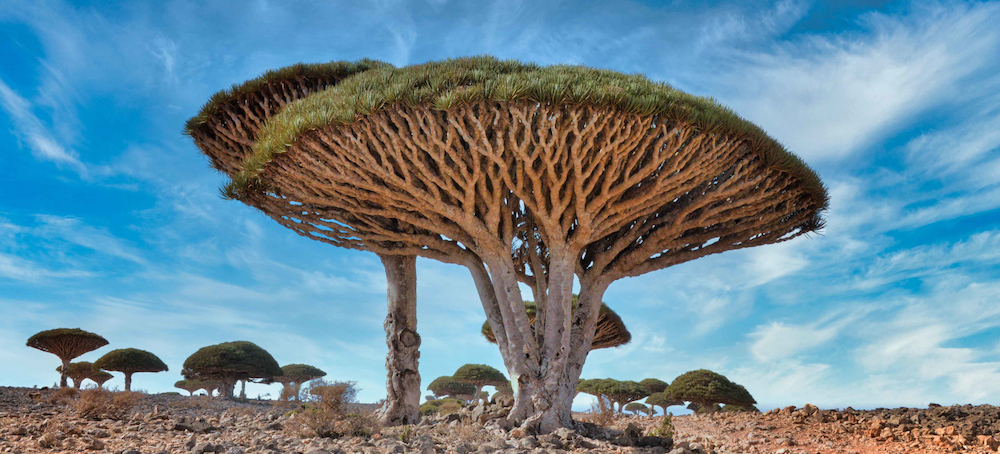1 in 3 Tree Species Worldwide at Risk of Extinction, Report Finds
Cristen Hemingway Jaynes EcoWatch Dragon’s blood trees, a vulnerable species on the IUCN Red List. (photo: Rod Waddington)
Dragon’s blood trees, a vulnerable species on the IUCN Red List. (photo: Rod Waddington) 1 in 3 Tree Species Worldwide at Risk of Extinction, Report Finds
Cristen Hemingway Jaynes EcoWatchThe assessment, led by Botanical Gardens Conservation International and the International Union for Conservation of Nature (IUCN) Species Survival Commission Global Tree Specialist Group, is an initiative that looks at the conservation status assessments of all Earth’s tree species on the IUCN Red List.
“Today, we are releasing the global assessment of the world’s trees on the IUCN Red List, which shows that more than one in three tree species are threatened with extinction. Trees are essential to support life on Earth through their vital role in ecosystems, and millions of people depend upon them for their lives and livelihoods,” said IUCN Director General Dr. Grethel Aguilar in a press release from IUCN. “As the IUCN Red List celebrates 60 years of impact, this assessment highlights its importance as a barometer of life, but also, crucially, as a unique tool guiding action to reverse the decline of nature.”
There are currently 166,061 animal, plant and fungi species on the IUCN Red List, 46,337 of which are threatened with extinction.
For the first time, most tree species in the world are on the Red List, with at least 16,425 of 47,282 of them found to be at risk of extinction.
Trees currently make up more than a quarter of IUCN Red List species. The amount of threatened trees is over two times that of all threatened mammals, birds, reptiles and amphibians put together. Across the globe, 192 countries have tree species that are at risk of being wiped off the planet.
“This comprehensive assessment presents the first global picture of the conservation status of trees, which enables us to make better informed conservation decisions and take action to protect trees where it is urgently needed,” said Dr. Malin Rivers, leader of the Global Tree Assessment at Botanic Gardens Conservation International, which partners with the Red List. “The work is a global effort, with over 1,000 tree experts involved. We need to continue to work together to scale up local, national and international tree conservation action to support people and the planet.”
Most threatened trees are found on islands throughout the world. Agriculture and urban development put island trees at an especially high risk of deforestation. Other threats include invasive species, diseases and pests.
The climate crisis increasingly threatens trees — particularly in the tropics — due to stronger, more frequent storms and sea-level rise.
“Addressing the threats that trees face, habitat protection and restoration, as well as ex situ conservation through seed banks and botanic garden collections are critical to prevent extinctions on islands and worldwide. Community action has already led to positive outcomes from the Juan Fernández islands to Cuba, from Madagascar to Fiji,” the press release said.
In South America, which has the most tree diversity anywhere, 3,356 of 13,668 species assessed are threatened with extinction. The biggest threats to trees in this part of the world are forest clearing to make way for crops and livestock ranching.
“The significance of the Global Tree Assessment cannot be overstated, given the importance of trees to ecosystems and people. We hope this frightening statistic of one in three trees facing extinction will incentivise urgent action and be used to inform conservation plans,” said Dr. Eimear Nic Lughadha, conservation assessment senior research leader at Royal Botanic Gardens, Kew, in the press release. “Although the proportion of tree species reported as threatened in South America — the world leader in tree diversity — is lower (25%), this percentage is sure to increase, because many tree species from South America have yet to be described for science and tree species new to science are more likely than not to be threatened with extinction.”
The Red List demonstrates that tree loss is also a big threat to thousands of animals, other plants and fungi. Trees are essential to life on Earth because of their role in water, carbon and nutrient cycles, climate regulation and soil formation.
Humans are reliant on trees, with more than 2,000 tree species used for food, medicines and fuels, and 5,000 IUCN Red List tree species used as timber for construction.
“Thriving, naturally diverse forests are essential in mitigating both climate change and biodiversity loss,” said Dr. Dave Hole, Conservation International’s Moore Center for Science vice president of global solutions, in the press release. “Without biodiverse ecosystems that include healthy and diverse tree populations the world will face an even greater climate threat than the one we are already facing. COP16 in Colombia this week represents a great opportunity for the public and private sectors to not just talk about — but to deliver — investments that benefit climate, species and people.”
